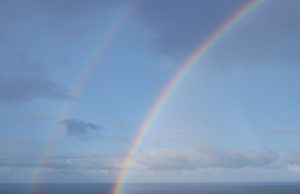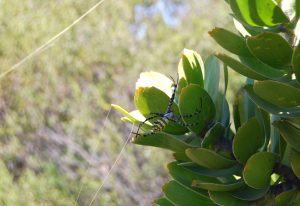 The < story of the beavers of Meldrum Creek is a wonderful analogy of faith and hope for the 21st Century for it teaches us that it is possible, as with so much else, for ecological wrongs to be righted before it’s too late. The early 20th Century conservationist John Muir wrote, “Earth has no sorrow that earth cannot heal….”
Nature is infinitely forgiving, and with the right conditions it has a powerful capacity to restore and heal itself. Sometimes it might need a bit of a human helping hand, as the Colliers gave to Meldrum Creek. However, if left entirely alone in time the natural world will return to its former pristine state in successions of growth, provided of course that it has not been damaged past the point of being able to recover.
In the Democratic Republic of Congo traces of human habitation have been found in the midst of tropical rainforests. These islands of grassland, which are surrounded by a vast sea of trees, could only once have been tracts of agricultural land from which the trees have long since been removed. Over time the empty grassland areas have begun to recover, whilst the human communities that chopped down the trees have long ago disappeared from the area.
The < story of the beavers of Meldrum Creek is a wonderful analogy of faith and hope for the 21st Century for it teaches us that it is possible, as with so much else, for ecological wrongs to be righted before it’s too late. The early 20th Century conservationist John Muir wrote, “Earth has no sorrow that earth cannot heal….”
Nature is infinitely forgiving, and with the right conditions it has a powerful capacity to restore and heal itself. Sometimes it might need a bit of a human helping hand, as the Colliers gave to Meldrum Creek. However, if left entirely alone in time the natural world will return to its former pristine state in successions of growth, provided of course that it has not been damaged past the point of being able to recover.
In the Democratic Republic of Congo traces of human habitation have been found in the midst of tropical rainforests. These islands of grassland, which are surrounded by a vast sea of trees, could only once have been tracts of agricultural land from which the trees have long since been removed. Over time the empty grassland areas have begun to recover, whilst the human communities that chopped down the trees have long ago disappeared from the area.
 The works of humankind are not forever. However tall and imposing they once were, they do not endure from one aeon to another. Unmaintained or forgotten, they soon crumble into decline and disappear. Whereas unless checked by a major environmental change, nature reproduces itself indefinitely.
The works of humankind are not forever. However tall and imposing they once were, they do not endure from one aeon to another. Unmaintained or forgotten, they soon crumble into decline and disappear. Whereas unless checked by a major environmental change, nature reproduces itself indefinitely.
Untended, small blades of grass soon begin to stubbornly push their way up between the paving stones of a neglected garden path until, eventually, they have covered it with riotous new growth. With adequate sunlight and rain, leveled tracts of ground soon begin to sprout vigorous green shoots, which rapidly grow into grass and then bushes, vines and trees. Barren open spaces, however once still and empty of life, retain the capacity to again resound with the abundant calls of exuberant bird and animal life. Nature will not be subdued for long. It soon reclaims its essence.
People who live closest to the Earth understand this fundamental principle. Like Lillian Collier’s Grandmother Lala, they understand and respect the ancient wisdom of the land; a wisdom that decrees that often it is the simple and practical that the land requires, and not the sophisticated and expensive.
 They also have a deep, ages-old understanding of the need to conserve in the present, so that there is a base to build from in the future. Ponds emptied of beaver, die for other species too. For all life on Earth is connected in a fragile web of interdependence, one species nourishing and perpetuating itself by preying on another.
They also have a deep, ages-old understanding of the need to conserve in the present, so that there is a base to build from in the future. Ponds emptied of beaver, die for other species too. For all life on Earth is connected in a fragile web of interdependence, one species nourishing and perpetuating itself by preying on another.
To people who live closest to the land, ownership of the soil, water and air of the planet is an alien concept. Instead of being short-term owners with proprietary rights that entitle landholders to do with the land as they see fit, these people see themselves as custodians of precious resources, protecting for the future what is here in the present and leaving as light a footprint as possible as evidence of their passing. Far from being an impossible ideal for the 21st Century, this should become the defining ideology of the present and future. The time has come. It is up to us now. Let the work begin.
You have come to the end of the book! I really hope you enjoyed reading it!!
Best wishes,
Carole Knight